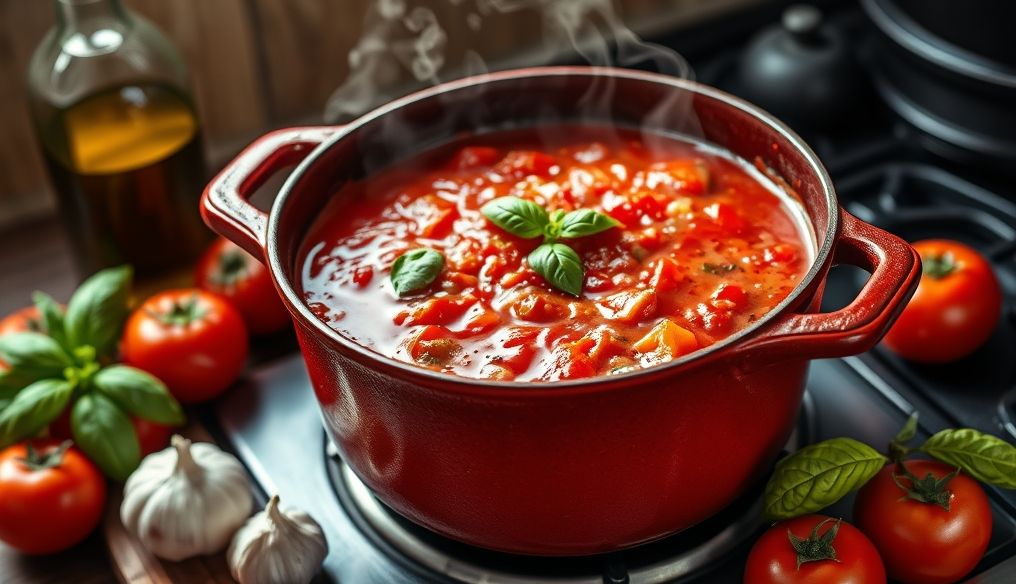How to Prepare the Perfect Tomato Sauce for Pasta That Tastes Better Than Restaurant Sauce?
Tomato sauce is the cornerstone of many delicious pasta dishes. Whether you prefer classic red sauce pasta, rich lasagna, or even delicious pizza, high-quality tomato sauce is the key to achieving an unforgettable flavor. But what makes a tomato sauce "perfect"? And how can you prepare it at home to rival, or even surpass, what you taste in the best restaurants?
1. Choosing the Right Tomatoes: The Foundation of Flavor
The first and most important step in preparing the perfect tomato sauce is choosing the right tomatoes. Tomatoes are the heart of the sauce, and their quality largely determines the final result. Here are some tips:
- Type: Look for tomato varieties with a rich flavor and dense flesh, such as San Marzano tomatoes or Roma tomatoes. These varieties have a lower water content and a higher sugar content, giving the sauce a thick consistency and a naturally sweet flavor.
- Ripeness: Choose fully ripe tomatoes with a deep red color and a slightly soft texture. Avoid green or hard tomatoes, as they will be less sweet and more acidic.
- Seasonality: During tomato season (usually in summer and autumn), tomatoes are at their best in terms of flavor and quality. Try to use fresh tomatoes during this period, or store some for use at other times of the year.
- Canned Tomatoes: If fresh tomatoes are not available, you can use high-quality canned tomatoes. Look for whole peeled tomatoes or crushed tomatoes in their own tomato juice. Avoid canned tomatoes that contain preservatives or added sugar.
2. Preparing the Tomatoes: Essential Steps
After choosing the right tomatoes, they must be prepared correctly before you start cooking them. Here are some essential steps:
- Washing: Wash the tomatoes well with cold water to remove any dirt or pesticide residue.
- Peeling (Optional): You can peel the tomatoes for a smoother sauce. There are several ways to peel them, including boiling the tomatoes briefly and then placing them in ice water to peel them easily, or using a vegetable peeler.
- Removing Seeds (Optional): If you prefer a less acidic sauce, you can remove the seeds from the tomatoes.
- Chopping: Chop the tomatoes into small pieces or cubes, as desired.
3. Other Essential Ingredients: Adding Depth and Flavor
In addition to tomatoes, there are some other essential ingredients that help add depth and flavor to the tomato sauce:
- Olive Oil: Use extra virgin olive oil to give the sauce a rich and fruity flavor.
- Garlic: Garlic is a staple in tomato sauce and adds a pungent and aromatic flavor.
- Onion: Onion adds sweetness and depth to the sauce.
- Herbs: Fresh or dried herbs, such as basil, oregano, and thyme, add an aromatic and refreshing flavor.
- Salt and Pepper: Use salt and pepper to season the sauce to taste.
4. Cooking Method: The Secret to Evolved Flavor
The cooking method is the key to getting a tomato sauce with an evolved and deep flavor. Here are some tips:
- Slow Cooking: Cook the sauce over low heat for a long time (at least an hour, or even several hours) to allow the flavors to blend and develop.
- Regular Stirring: Stir the sauce regularly to prevent it from sticking to the bottom and burning.
- Tasting and Adjusting: Taste the sauce regularly and adjust the spices to taste. You can add more salt, pepper, herbs, or even a little sugar to achieve the perfect balance of flavor.
5. Extra Touch: Secret Ingredients to Add Distinction
To add an extra touch of distinction to the tomato sauce, you can try adding some secret ingredients:
- Tomato Paste: Adding a teaspoon of tomato paste helps thicken the sauce and enhance the tomato flavor.
- Sugar: Adding a pinch of sugar helps balance the acidity of the tomatoes.
- Balsamic Vinegar: Adding a few drops of balsamic vinegar adds a complex sweet and sour flavor.
- Crushed Red Pepper: Adding a little crushed red pepper adds a touch of heat.
- Bay Leaf: Adding a bay leaf while cooking adds a pleasant aromatic flavor.
6. Tips for Achieving the Perfect Consistency
The perfect consistency of tomato sauce depends on your personal preferences. If you prefer a thick sauce, you can let it simmer over low heat for a longer time to reduce the amount of liquid. You can also use a potato masher or hand blender to mash the sauce partially or completely. If you prefer a smoother sauce, you can strain the sauce through a fine-mesh sieve to remove any large pieces of tomato, onion, or garlic.
7. Storing Tomato Sauce: Preserving the Flavor
Tomato sauce can be stored in the refrigerator for up to 3-4 days. You can also freeze the sauce in airtight bags or containers for up to 3 months. When reheating frozen sauce, let it thaw in the refrigerator first, then heat it over low heat.
8. Simple Recipe for the Perfect Tomato Sauce
This is a simple recipe for the perfect tomato sauce that you can adjust to your liking:
Ingredients:
- 1 kg fresh tomatoes (San Marzano or Roma)
- 1/4 cup extra virgin olive oil
- 2 cloves garlic, minced
- 1/2 onion, chopped
- 1 teaspoon dried oregano
- 1/2 teaspoon dried basil
- Salt and pepper to taste
- 1 teaspoon tomato paste (optional)
- Pinch of sugar (optional)
Instructions:
- Wash the tomatoes and chop them into cubes.
- In a large pot, heat the olive oil over medium heat.
- Add the garlic and onion and sauté until the onion is translucent.
- Add the tomatoes, oregano, basil, salt, and pepper.
- Bring the sauce to a boil, then reduce the heat and simmer for at least an hour, or until thickened.
- If using tomato paste or sugar, add them in the last 15 minutes of cooking.
- Taste the sauce and adjust the spices to taste.
- Use the sauce immediately or store it in the refrigerator or freezer.
9. Common Mistakes and How to Avoid Them
There are some common mistakes to avoid when preparing tomato sauce:
- Using unripe tomatoes: Unripe tomatoes will make the sauce acidic and not sweet.
- Overcooking: Overcooking can make the sauce bitter.
- Not seasoning the sauce properly: Proper seasoning is key to getting a delicious sauce.
- Not stirring regularly: Not stirring regularly can lead to the sauce burning.
10. Innovative Ideas for Using Tomato Sauce
Tomato sauce isn't just for pasta. Here are some innovative ideas for using it:
- Pizza Base: Use tomato sauce as a base for pizza.
- Dipping Sauce: Use tomato sauce as a dipping sauce for french fries or vegetables.
- Addition to Soup: Add tomato sauce to soup to add flavor and depth.
- Sauce for Meat and Chicken: Use tomato sauce as a sauce for meat and chicken.
- Sauce for Grilled Vegetables: Use tomato sauce as a sauce for grilled vegetables.
By following these tips and recipes, you can prepare the perfect tomato sauce for pasta at home, and enjoy a rich and distinctive flavor that surpasses store-bought restaurant sauces. Enjoy!




